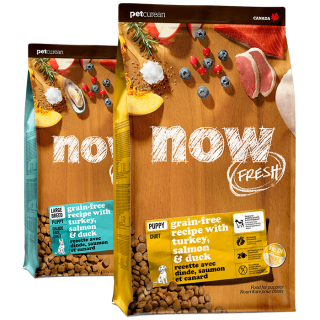April 12, 2021
What You Need to Know About Omega-3 and Omega-6 in Dog Food

Fats are an important component of your dog's diet and are necessary when it comes to creating a balanced diet. Fatty acids are the building blocks of fat and some are considered 'essential' because the body can't naturally make them on their own. Therefore, it is important that your dog is getting these from the food they eat.
Dogs require two types of essential fatty acids: omega-3 and omega-6. These essential fatty acids have crucial roles in cell membranes, the immune system, and the circulatory system.
What are Omega-3 & 6 Fatty Acids?
Omega-3 and 6 fatty acids are polyunsaturated fatty acids that are important for normal metabolism and optimal health.
Omega-3 fatty acids are great for your dog's body and brain. They are known to have anti-inflammatory properties, and can help promote hydrated, healthy skin and coat, support relief from itchy skin, and can also support healthy joints.
Omega-6 fatty acids are involved in many bodily processes as well, including skin health and blood clotting. Neither category is more important than the other, and the overall ratio between omega 6:3 fatty acids is key.
The Balance of Omega-3 and Omega-6 in Dog Food
Like all things in life, balance is important – even for fatty acids! Many fats and oils are higher in omega-6 than omega-3, but your dog's food needs to contain a balance of both.
The National Research Council (NRC) recommends a ratio of 2.6:1 to 26:1 omega-6 to omega-3.1 The Association of American Feed Control Officials dog and cat nutrient profiles include a maximum omega-6 to omega-3 ratio of 30:1.3 For comparison, the recommended intake for humans is 5:1 to 10:1 omega-6 to omega-3.4 It is important to note that within this provided range there is no one ‘perfect’ ratio.
Balanced dietary omega-3 and omega-6 fatty acids is important as these fatty acids are metabolised into substances which affect inflammation. Omega-3s are considered less inflammatory than omega-6s. When these are off-balance, it can contribute to a chronic state of low-grade inflammation which has been associated with the development of certain diseases such as obesity, cancer and diabetes.
Which Ingredients do Omega-3 and Omega-6 Come From?
Omega-3 and omega-6 can come from many sources but are primarily found in plant and animal fats and oils as well as meats, poultry and fish. Some important fatty acids, and their sources are:
Omega-3 Fatty Acids:
- Alpha-linolenic acid (ALA): a plant-based omega-3 found in flaxseed and canola oil
- Eicosapentaenoic acid (EPA): a marine-based omega-3 found in de-boned salmon and salmon oil
- Docosahexaenoic acid (DHA): a marine-based omega-3 found in de-boned salmon, salmon oil, and marine microalgae oil
ALA, EPA and DHA are considered essential fatty acids in growing dogs. Although adult dogs can make EPA and DHA from ALA, the conversion rate is low. Therefore, it's typically recommended for optimal health that dietary sources of all three types of omega-3 fatty acids are consumed. In particular, DHA is vital for brain and immune system development, as well as eye function in young, growing pups.
Omega-6 Fatty Acids:
- Linoleic Acid (LA): found in most plant and animal fats and oils, including chicken fat and canola oil
Linoleic acid is an omega-6 polyunsaturated fatty acid that is considered the most important essential fatty acid for dogs. Omega-6 plays a significant role in your dog's skin health by maintaining the skin's outermost water barrier. Additionally, many other essential molecules in the body are made from linoleic acid.
Summary
By understanding the importance of omega-3s and omega-6s in your dog's food and how to identify sources of them into your dog's diet, it will help you to choose a complete and balanced diet for them. Keeping a balance of omega-3 and omega-6 fatty acids helps ensure optimal health since each fatty acid plays a different role in your pup’s body.

Our Recommendation
Puppy Recipes for Every Size
Each carefully crafted recipe for puppies contains perfectly balanced nutrients to support healthy growth and development.
View puppy food
If you're still unsure how omega 3 and 6 fatty acids fit into your dogs’ nutritional needs, talk to your veterinarian or a trusted pet nutritionist.
National Research Council. Nutrient Requirements of Dogs and Cats. Washington, D.C.: The National Academies Press; 2006.
Zicker SC, Jewell DE, Yamka RM, Milgram NW. Evaluation of cognitive learning, memory, psychomotor, immunologic, and retinal functions in healthy puppies fed foods fortified with docosahexaenoic acid-rich fish oil from 8 to 52 weeks of age. J. Am. Vet. Med. Assoc. 2012;241(5):583-594.
Association of American Feed Control Officials. 2016 Official Publication. Oxford, IN: Association of American Food Control Officials Inc.; 2016.
Institute of Medicine. Dietary Reference Intakes for Energy, Carbohydrate, Fiber, Fat, Fatty Acids, Cholesterol, Protein, and Amino Acids (Macronutrients). Washington, D.C.: National Academy Press; 2005.


